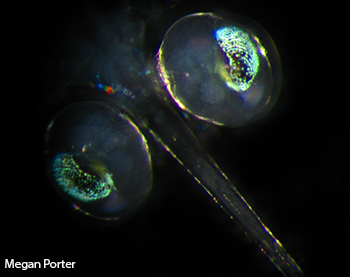
The eyes of a last stage Pullosquilla thomassini larva
Stomatopod (or mantis shrimp) larvae are transparent, which makes them nearly invisible in their ocean habitat. However, their compound eyes remain opaque, owing to screening pigments needed between photoreceptors to preserve image resolution—a characteristic that could make the otherwise transparent larvae easy pickings for a predator’s afternoon snack. Researchers from the University of Maryland, Baltimore County, USA, report that they’ve demonstrated how the larvae avoid that fate: the immature shrimp use “eyeshine,” reflected light from structures overlying their retinas, as mirror camouflage to mask these pigments and blend in with the light in their surroundings (J. Exp. Biol. doi:10.1242/jeb.108076).
Authors Kathryn Feller and Thomas Cronin tested their hypothesis at the Lizard Island Research Station on Australia’s Great Barrier Reef. They photographed stomatopod larvae both in the lab and in the ocean, and analyzed their spectral reflectance. The larval eyes strongly reflect blue or green wavelengths of light, and when the researchers multiplied the eyeshine reflectances by the irradiance spectrum measured in the imaging environment, they uncovered a close match between the wavelength of the eyeshine and the radiance spectra of the background light.
They then calculated the Michelson contrast values between the eyespot and the background, and found virtually no contrast between the eye reflections and the surrounding environment. Feller and Cronin also noted that the structure responsible for eyeshine is absent from the optical pathway of light absorbed by photoreceptors. That suggests that eyeshine is not related to photoreception and lends strength to the argument that its function is to provide camouflage. To assess whether eyeshine spectra are adaptive to particular habitats, the researchers calculated the eyeshine that a non-endemic species, Squilla empusa from the Western Atlantic Ocean, would produce in the Lizard Island environment, and determined that it was a poor match to this non-native light background.
Further research will explore why one particular species, Pullosquilla thomassini, has an unusual blue and green regionalized eyeshine, and will attempt to characterize the photonic structures that produce eyeshine.
